|
Priй: Nimzo London System A46
1.d4
Nf6
2.Nf3
e6 3.Bf4
c5
|
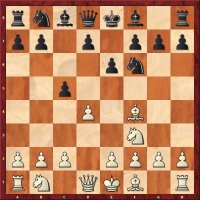 |
|
The author takes a critical look at Moskalenko’s
article on 4.e3
Qb6
in CBM 125 and then concentrates in detail on
what he considers a superior move: 4.c3!
A46 Nimzo-London 2...e6 3.Bf4 |
Stohl: Caro-Kann B12
1.e4
c6 2.d4 d5 3.e5 c5
(4.c4)
 |
|
With 3…c5 Black successfully avoids the main
variations. A very recent reply is then the
radical 4.c4 (or also first 4.Nf3,
and then c2-c4).
B12 Caro-Kann Advance |
Rogozenco: Sicilian Dragon B78
1.e4
c5 2.Nf3
d6 3.d4 cxd4 4.Nxd4
Nf6
5.Nc3
g6 6.Be3
Bg7
7.f3 0-0 8.Qd2
Nc6
9.Bc4
Bd7
10.0-0-0
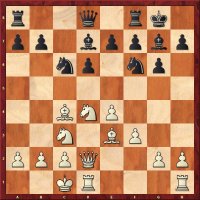 |
|
In 2008 there have been some developments in the
Dragon Variation. Rogozenco sums up the
innovations in the Chinese Dragon (10…Rb8)
and in the Carlsen-Variation 10…Ne5
11.Bb3
Rc8
12.Kb1
a6.
B78 Sicilian Dragon |
Langrock: French Defence C03
1.e4
e6 2.d4 d5 3.Nd2
Be7
4.Bd3
c5 5.dxc5
Nf6
6.Qe2
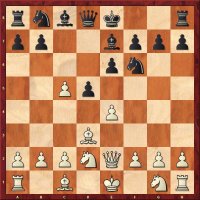 |
|
After 4.Ngf3
in the first part, Langrock this time deals with
what he considers the more critical variation 4.Bd3.
But here too things are ok for Black, and from
the position in the diagram he even examines two
possible moves (6…Nc6
and 6…0-0).
C03 French Defence 3.Nd2 Be7 |
Kritz: French Defence C11
1.e4
e6 2.d4 d5 3.Nc3
Nf6
4.e5
Nfd7
5.f4 c5 6.Nf3
Nc6
7.Be3
Be7
8.Qd2
0-0
 |
|
Holding back with the capture on d4 is actually
very venomous, because after, e.g., 9.0-0-0?
there is the strong reply 9…c4. However, Kritz
shows how, beginning with 9.dxc5, White gets
good chances of an opening advantage.
C11 French Defence 3.Nc3 Nf6 4.e5 |
Karolyi: Ruy Lopez C68
1.e4
e5 2.Nf3
Nc6
3.Bb5
a6 4.Bxc6
dxc6 5.0-0
Qd6
6.Na3
b5
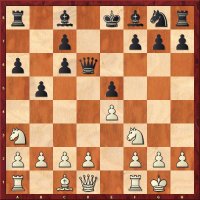 |
|
The Exchange Variation of the Ruy Lopez remains
a popular choice, and it is important to have a
good weapon against it. Karolyi offers a
repertoire for Black based on 5…Qd6.
C68 Ruy Lopez Exchange 5...Qd6 |
Postny: Ruy Lopez C88
1.e4
e5 2.Nf3
Nc6
3.Bb5
a6 4.Ba4
Nf6
5.0-0
Be7
6.Re1
b5 7.Bb3
0-0 8.h3
Bb7
9.d3 d5
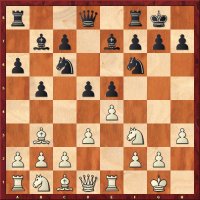 |
|
Like 8.a4, the move 8.h3 is one of the important
Anti-Marshall Variations. But after 9…d5, as
analysed by Postny, we are again reminded of the
Marshall Attack: Black sacrifices a pawn and
obtains good compensation for it.
C88 Ruy Lopez Anti-Marshall 8.h3 |
Marin: Ruy Lopez C90
1.e4
e5 2.Nf3
Nc6
3.Bb5
a6 4.Ba4
Nf6
5.0-0
Be7
6.Re1
b5 7.Bb3
d6 8.c3
Na5
9.Bc2
c5 10.d4
Qc7
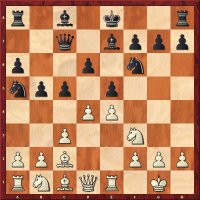 |
|
If as Black you play the Chigorin Variation
(8…0-0 9.h3
Na5
10.Bc2
c5), then adopting the Accelerated Chigorin
Variation as introduced by Marin allows you to
avoid the Yates Variation (8…0-0 9.d4).
C90 Ruy Lopez 8...Na5 |
Breutigam: Queen's Gambit D06
1.d4
d5 2.c4 c5
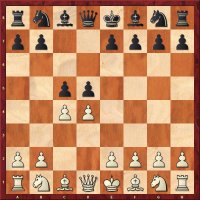 |
|
As the author shows, it is not at all easy for
White to obtain an advantage against the bold
pawn advance. The danger of a draw is high, but
if you do not know what you are doing you can
quickly land up in worse positions.
D06 Symmetrical Defence 2.c4 c5 |
Rogozenco: Slav Defence D10
1.d4
d5 2.c4 c6 3.Nc3
dxc4 4.e4 b5 5.a4 b4 6.Na2
Nf6
7.e5
Nd5
8.Bxc4
e6 9.Nf3
Ba6
 |
|
3.Nc3
allows White to avoid numerous lines, but the
immediate 3…dxc4 constitutes a disadvantage.
Black can easily equalise with the variation
introduced here and above all with the
surprisingly simple 9…Ba6.
D10 Slav Defence 3.Nc3 dxc4 |
Ftacnik: Slav Defence D11
1.d4
d5 2.c4 c6 3.Nf3
Nf6
4.e3
Bg4
5.h3
Bh5
 |
|
The author follows up his article in CBM 126,
where he examined 5…Bxf3.
After 5…Bh5
the bishop is at first preserved, though it is
usually exchanged later on g6. White probably
does not obtain an opening advantage.
D11 Slav Defence 5.h3 Bh5 |
Krasenkow: Semislav D45
1.d4
d5 2.c4 c6 3.Nf3
Nf6
4.Nc3
e6 5.e3
Nbd7
6.Qc2
Bd6
7.g4
Nxg4
8.Rg1
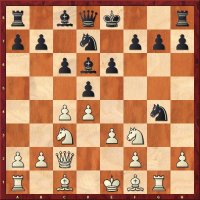 |
|
Why should one not actually accept the
Shabalov-Shirov Gambit? After a
Morozevich-Kramnik game, this logical
continuation could gain in popularity; as
Krasenkow shows, it is surprisingly full of
possibilities.
D45 Semi-Slav 7.g4 Nxg4 |
Marin: Catalan Opening E05
1.d4
Nf6
2.c4 e6 3.g3 d5 4.Nf3
Be7
5.Bg2
0-0 6.0-0 dxc4 7.Qc2
a6 8.a4
Bd7
9.Rd1
Bc6
10.Nc3
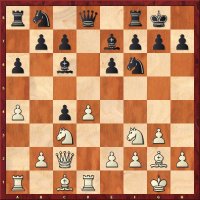 |
|
After 8.a4 and once more 9.Rd1,
White can in this case choose a sideline, but
nevertheless there are still prospects of an
opening advantage. Marin once more analyses the
variations in great depth.
E05 Catalan 8.a4 |
Grivas: Queen's Indian E16-E19
1.d4
Nf6
2.c4 e6 3.Nf3
b6 4.g3
Bb7
5.Bg2
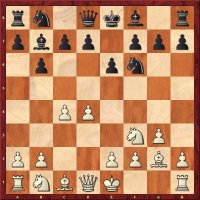 |
|
In the second part of his repertoire for White
against the Queen’s Indian, Grivas looks into
the old main line 4…Bb7.
Our author is once more able to offer his some
of his own games for consideration.
E16 Queen's Indian 4...Bb7 |
|